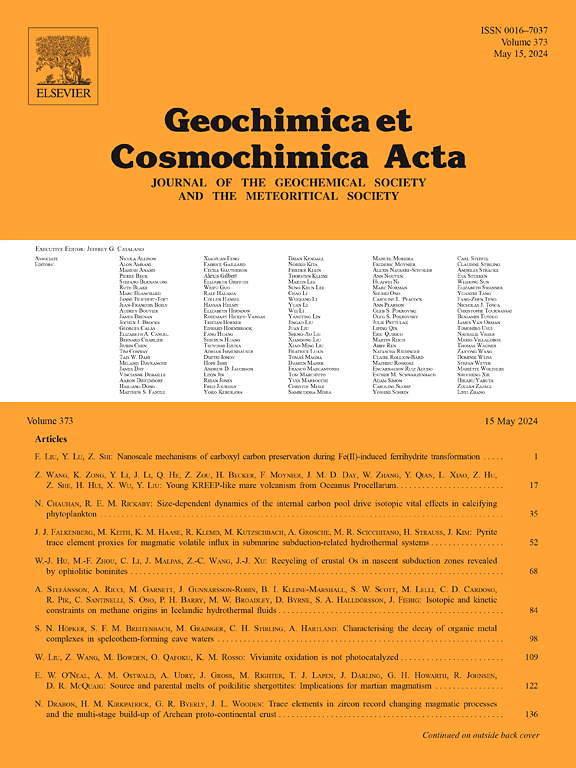Isotopic fractionation of Li and B in highly evolved granitic systems
IF 4.5
1区 地球科学
Q1 GEOCHEMISTRY & GEOPHYSICS
引用次数: 0
Abstract
The incompatible elements lithium (Li) and boron (B) generally show different degrees of isotopic fractionation during magmatic differentiation and fluid exsolution in highly evolved granitic pegmatite systems. We use the magmatic-hydrothermal evolution of the Qiongjiagang pegmatite-type Li deposit to demonstrate how fractionation and phase separation control the Li and B isotopic compositions of whole rock samples. The investigated samples include tourmaline-muscovite granites, unmineralized pegmatites, aplites, spodumene pegmatites and their associated wall rocks. Our data show systematic Li and B isotopic compositional variations among the studied rocks. The spodumene pegmatites have much higher Li concentrations, lower δ7Li values, and lower B concentrations and δ11B values than the tourmaline-muscovite granites, unmineralized pegmatites and aplites, which suggests phase separation into a fluid-rich melt and a fluid-poor melt. The fluid-rich melt experienced multi-stage magmatic differentiation with fluid exsolution, which eventually led to the formation of spodumene pegmatites. In contrast, the fluid-poor melt evolved through single-stage magmatic differentiation, eventually forming unmineralized pegmatites and aplites. Interactions with wall rocks modified the Li and B isotopic compositions of some aplite and unmineralized pegmatite samples. The Li and B isotopic compositions of minerals extracted from tourmaline-muscovite granite, unmineralized pegmatite, and spodumene pegmatite samples were also analyzed. The Li and B isotopic compositions of these minerals span a wide range, which is controlled by two primary factors: (i) coordination of Li and B and (ii) crystallization history. The crystallization of most magmatic minerals increases the δ7Li and δ11B values of the residual melt (except for tourmaline, whose crystallization seems not to change the δ11B values of the residual melt significantly). For minerals with the same coordination of Li and B, the δ7Li and δ11B values are higher for later crystallized minerals. As the δ7Li and δ11B values of magmatic minerals are affected by the amount of Li and B that has been removed from the melt before these minerals crystallized, bulk-rock δ7Li and δ11B values are generally more reliable tracers of the source and evolution of melts than the δ7Li and δ11B values of minerals that crystallized from such a melt. Only if the budgets of Li or B are dominated by one single phase, δ7Li and δ11B values of minerals and bulk rocks are the same.
高演化花岗岩体系中Li和B的同位素分馏
在高度演化的花岗伟晶岩体系中,不相容元素锂(Li)和硼(B)在岩浆分异和流体溶蚀过程中普遍表现出不同程度的同位素分异。本文利用琼家岗伟晶岩型锂矿床的岩浆-热液演化,论证了分选和相分离对整个岩石样品中Li和B同位素组成的控制作用。研究样品包括电气石-白云母花岗岩、未矿化伟晶岩、黑石伟晶岩、锂辉石伟晶岩及其伴生围岩。我们的数据显示了所研究岩石中Li和B同位素组成的系统性变化。锂辉石伟晶岩的Li浓度、δ7Li值、B浓度和δ11B值明显高于电气石-白云母花岗岩、未矿化伟晶岩和斜长石,表明其相分离为富流体熔体和贫流体熔体。富流体熔体经历了多期岩浆分异和流体溶蚀,最终形成辉石伟晶岩。相比之下,缺乏流体的熔体通过单阶段岩浆分异演化,最终形成未矿化的伟晶岩和斜晶岩。与围岩的相互作用改变了部分辉长岩和未矿化伟晶岩样品的Li和B同位素组成。分析了电气白云母花岗岩、未矿化伟晶岩和锂辉石伟晶岩样品中提取的矿物的Li和B同位素组成。这些矿物的Li和B同位素组成范围较广,主要受两个因素的控制:(1)Li和B的配位和(2)结晶历史。大部分岩浆岩矿物的结晶作用使残余熔体的δ7Li和δ11B值增大(电气石除外,其结晶作用对残余熔体的δ11B值变化不大)。对于Li和B配位相同的矿物,较晚结晶的矿物δ7Li和δ11B值较高。岩浆岩矿物的δ7Li和δ11B值受熔体结晶前已从熔体中移出的Li和B量的影响,因此块状岩石的δ7Li和δ11B值通常比从熔体中结晶的矿物的δ7Li和δ11B值更可靠地示踪熔体的来源和演化。只有当Li或B的收支以单一相为主时,矿物和块状岩石的δ7Li和δ11B值才相同。
本文章由计算机程序翻译,如有差异,请以英文原文为准。
求助全文
约1分钟内获得全文
求助全文
来源期刊

Geochimica et Cosmochimica Acta
地学-地球化学与地球物理
CiteScore
9.60
自引率
14.00%
发文量
437
审稿时长
6 months
期刊介绍:
Geochimica et Cosmochimica Acta publishes research papers in a wide range of subjects in terrestrial geochemistry, meteoritics, and planetary geochemistry. The scope of the journal includes:
1). Physical chemistry of gases, aqueous solutions, glasses, and crystalline solids
2). Igneous and metamorphic petrology
3). Chemical processes in the atmosphere, hydrosphere, biosphere, and lithosphere of the Earth
4). Organic geochemistry
5). Isotope geochemistry
6). Meteoritics and meteorite impacts
7). Lunar science; and
8). Planetary geochemistry.
 求助内容:
求助内容: 应助结果提醒方式:
应助结果提醒方式:


